Water, Water Everywhere… But Not a Drop in Your Sacred Space!
Of all the natural forces that can deteriorate your sacred space— wind, sun, and water in the form of rain, snow, and ice—water has the potential to cause the most damage. Nearly every part of a building’s exterior was designed to keep water out. But suppose the “building envelope” is not maintained? In that case, water may attack exterior elements (masonry, wood, painted finishes) or seep into the building, silently wreaking havoc over time on ceilings, walls, interior finishes, and structural supports such as roof rafters. This damage can sometimes take years to become visible from the inside, and by the time you can see it, you may have an expensive renovation on your hands. What follows are some proactive ways to keep your building water-tight.
Roofs
The roof is your building’s first “line of defense” against water infiltration, which is why almost every congregation faces roof repair or replacement at some point. Roofs are designed to keep water out of the building and channel water down and away from the building foundation. Metal flashings provide a water-tight seal around chimneys, dormers, and other transitions where horizontal roof surfaces meet vertical architectural elements. Roof slopes direct water off the roof’s surface into gutters and downspouts, channeling water into an underground sewer system or deposit water at ground level.
To keep your roof and water conduction system (gutters and downspouts) functioning correctly:
- Replace worn or missing roofing shingles, tiles, or slates so that you have complete roof coverage. On flat roofs, look for cracks or open seams in the roof membrane. On metal roofs, look for small holes and open seams.
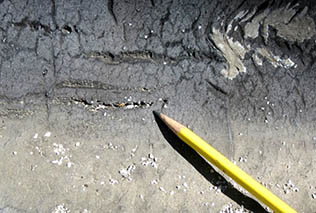
- Re-attach loose flashings and replace them where they are missing. Make sure the tops of the flashings are tucked into masonry joints or closed with sealant to keep them water-tight.
- Keep gutters and downspouts clear of leaves and other debris, so they do not clog.
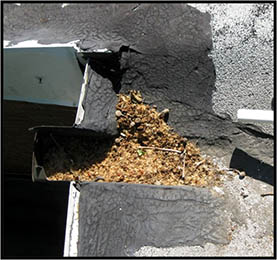 Look for holes or open seams in gutters and downspouts that will allow water to wash over the building, saturating materials and allowing moss and other plants to grow on the surface. These plants hold moisture and contribute to material deterioration.
Look for holes or open seams in gutters and downspouts that will allow water to wash over the building, saturating materials and allowing moss and other plants to grow on the surface. These plants hold moisture and contribute to material deterioration.
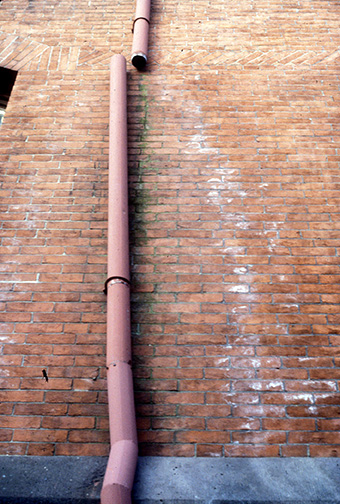
Masonry Walls
Brick and stone masonry walls are also designed to keep water out. When the mortar between these masonry units is deteriorated or missing, water can seep into the building through these gaps in the wall surface. If water seeps into open mortar joints during the winter, the water may freeze and expand, exerting pressure on the surrounding masonry.
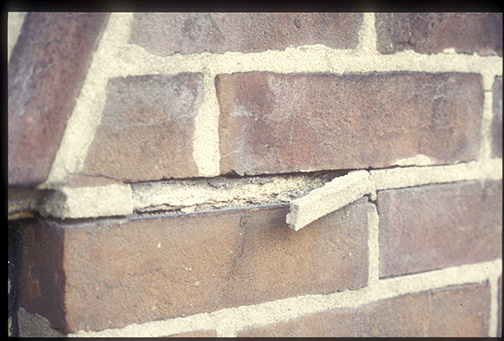
Most buildings expand and contract as the outside air temperature changes during the year. Mortar is the element in the masonry wall system that accommodates this normal thermal movement. An appropriate mortar for historic masonry buildings has some lime in it because the lime gives the mortar enough flexibility to allow for normal expansion and contraction. (A typical mix is a Type N: 1 part Portland cement, 1 part lime, and 6 parts sand.) Avoid using Portland mortars without adding lime because they are usually harder than brick or even stone masonry and will cause cracks in surrounding masonry units, or separate from the masonry, leaving gaps where water can penetrate. To maintain exterior masonry:
- Replace deteriorated or missing mortar with an appropriate mortar that includes lime in the mix. (See the National Park Service Preservation Brief on mortar for guidance on mortar color and appropriate pointing techniques, available online at https://www.nps.gov/tps/how-to-preserve.htm. Click on Preservation Briefs and then select Brief 2, “Repointing Mortar Joints.”)
- Look for settlement cracks around windows and doors— open mortar joints in a step pattern, usually at the top or bottom or beginning at the corners. These open joints should be repointed and monitored. If cracks persist, retain the services of a qualified conservator or structural engineer to determine whether additional work is needed (for example, the lintel at the top of the opening may require replacement).
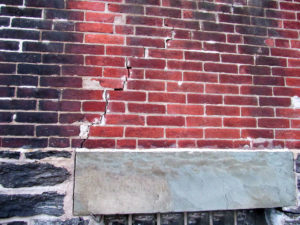
- Do not forget to look at masonry elements far above eye level, such as chimneys and towers. (Binoculars are not just for bird watching!)
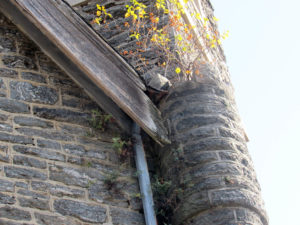
Wood Windows, Doors, and Siding
Wood windows and doors allow the nice weather in, and more importantly, keep the nasty weather out! The easiest way to maintain these wooden building elements and features—and clapboard siding, cornices, and brackets— is to keep them painted. Unpainted wood will absorb water quickly, and wet wood will eventually rot. It is essential to replace missing and deteriorated window glazing putty, which keeps water (and air) from seeping around the window glass and, with small metal glazing points, helps to keep the glass in place.
- Look for signs of glazing putty deterioration such as cracking and water staining or peeling paint on the interior sides of the window muntins.
- Look for staining or peeling paint, especially at window and door sills, and along the bottom of doors where water may pool on a door threshold, and at downspout locations in cornices.
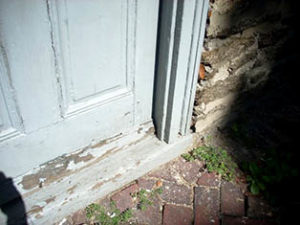
- Fill the gap between windows and doors and surrounding masonry with a flexible sealant to keep water out.
All building materials and systems have a natural life span and may need to be repaired or replaced simply because they have reached the end of their useful life. With diligent and proper maintenance, you can help minimize the need for and frequency of significant repairs.

